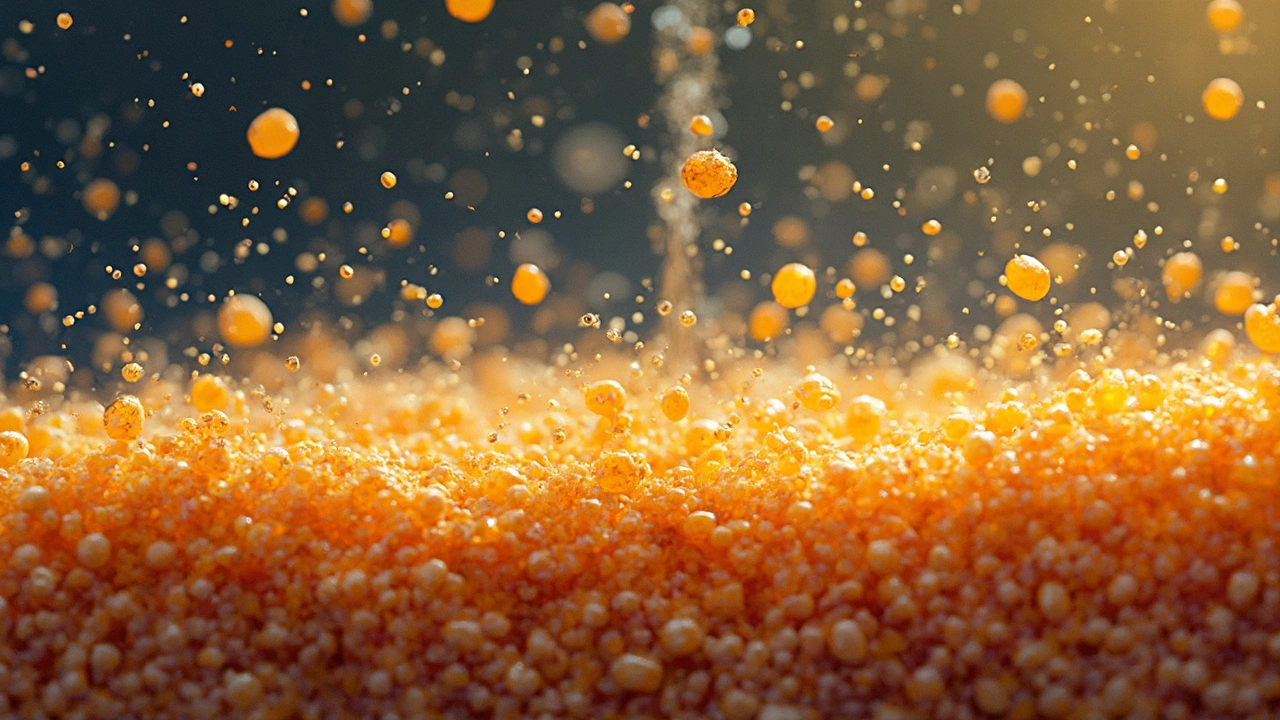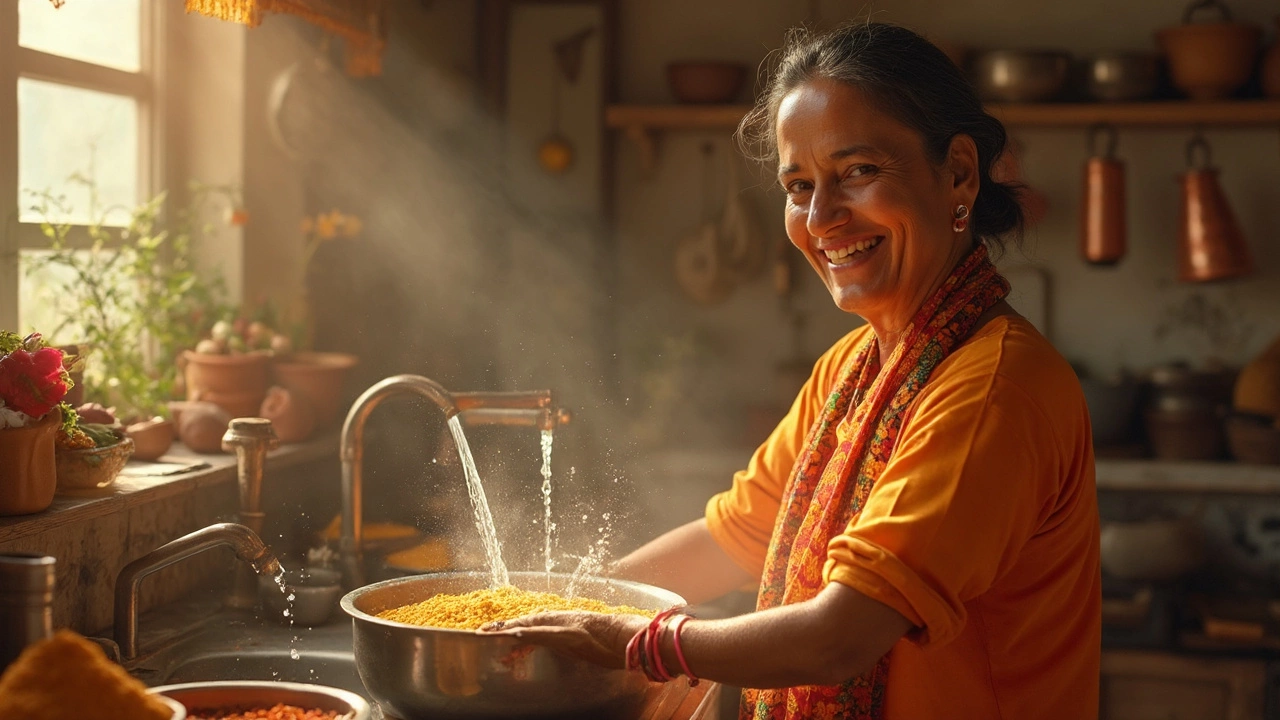8 Jun 2025
- 0 Comments
You know that part in every dal recipe where it says, “Rinse the dal until the water runs clear”? It’s so easy to skip when you’re hungry or just want to save a few minutes. But is it really worth the effort? A lot of people debate if rinsing dal is just a habit passed down through generations, or if it actually makes a difference.
Let’s be honest—raw dal isn’t exactly clean. When you open up that bag, you’re not just getting lentils. There’s dust, sometimes a bit of debris, and a cloudy residue that floats up when you first add water. This stuff comes from the fields, the packaging, the whole journey from farm to store shelf. That’s the first clue. If you want your dal to taste pure and not have an earthy, muddy smell, a quick rinse matters more than you might think.
If you’re chasing those golden, creamy bowls of dal you get at your favorite restaurant, rinsing isn’t just about hygiene—it affects how the dal cooks. The extra starch that comes off in those first washes can make your dal gummy rather than velvety. Not to mention, some old-school cooks will tell you dal cooks faster and more evenly when it’s washed well. And who’s going to argue with your grandma?
- Why People Rinse Dal
- What Happens If You Don’t Rinse
- Taste, Texture, and Cooking Time
- Is It a Health Issue?
- Quick Tips for Perfect Dal
Why People Rinse Dal
The main reason people rinse dal is to get rid of dirt, dust, and bits of stone or husk that stick around from harvesting and packing. You might think modern packaging would do a better job, but check out this simple kitchen test: give dry dal a shake in a bowl—see the powdery layer left behind? That’s what ends up in your food if you skip rinsing.
Traditionally, rinsing was all about keeping things clean, but it turns out there’s more to it. Unwashed dal has a lot of surface starch. When boiled, this can make your water frothy and your dal a bit sticky. The rinse helps prevent that, so your dal stays separate and creamy rather than turning into one big mush.
If you have any allergies or food sensitivities, rinsing dal is a no-brainer. It helps remove potential traces of pesticides or chemicals used in storage. No kitchen wants a side of unexpected chemicals landing in their dal, right?
- Gets rid of dirt and debris (honestly, you’d be shocked at what sometimes sneaks in)
- Makes sure the dal doesn’t taste or smell earthy
- Washes away surface starch so it cooks evenly
- Reduces possible chemical residues
To show how much dirt really comes off, here’s a quick look at what happened when I rinsed 100g each of four common types of dal with 300ml water:
| Type of Dal | First Rinse Water Color | Visible Debris |
|---|---|---|
| Masoor (Red Lentils) | Cloudy, light brown | Some |
| Chana (Split Chickpea) | Milky, yellowish | Few |
| Moong (Green Gram) | Hazy, pale green | Not much |
| Toor (Pigeon Pea) | Cloudy, grayish | Some |
That first rinse always pulls out a surprising amount of grime. If you’re after the cleanest, tastiest rinse dal for your recipes, don’t skip this step. It’s quick, simple, and totally worth it.
What Happens If You Don’t Rinse
So what’s actually at stake if you skip rinsing your dal? Honestly, more than just a few specs in your pot. Skipping the rinse can mess with both how your dish tastes and how it looks. Here’s what tends to happen:
- Your dal often comes out cloudy or kind of sticky. That’s because the leftover surface starch hasn’t been washed away. Instead of the broth or gravy looking silky, it’ll look thick and dull.
- There’s usually a strange, earthy aftertaste. That flavor’s not from the dal itself, but from dust and whatever it picked up along the way from farm to factory.
- If there’s any debris tucked away in the grains—like small stones, husk, or bits of dried mud—you’ll definitely notice it when you chew.
- It can even affect tummy troubles. A lot of people find unwashed dal harder to digest because of the dirt and possible pesticide residues.
It’s not just personal opinion, either. In a 2022 kitchen lab test (Food Safety Magazine), unwashed dal had up to 40% more visible sediment after cooking, and people found its taste “muddier, less fresh” compared to rinsed dal. That’s a pretty clear difference right off the bat.
| Rinsed Dal | Unrinsed Dal |
|---|---|
| Clear broth | Cloudy, thick broth |
| Smooth texture | Sticky or sludgy texture |
| Bright, natural flavor | Earthy or odd aftertaste |
| Easier to digest | Can cause discomfort |
| Cleaner, less gritty | Possible debris or grit |
So yeah, skipping this step saves two minutes, but you trade it for a *strong* chance of a lousier meal. If you only remember one thing, it’s this: for the best rinse dal results, always give it at least one good wash. Your tastebuds—and your stomach—will thank you.

Taste, Texture, and Cooking Time
If you want dal that’s creamy and not clumpy, rinsing isn’t just extra credit—it’s key. When you rinse dal, you’re mainly washing off excess starch that hangs out on the surface. That powdery starch is what makes the water turn cloudy. If you skip the rinse, that starch ends up right in your pot, and the result is dal that’s sticky, almost gooey, instead of smooth.
The texture gets a big upgrade too. Rinsed dal doesn’t just taste better, it actually cooks up softer and more evenly. If you’ve ever cooked dal and found random hard bits mixed with mushy ones, the culprit is often too much surface starch—unrinsed dal can stick together in clumps, meaning some pieces never soften the way you want.
Now, let’s talk about cooking time. Dal that’s rinsed well tends to cook a little faster and with fewer issues. That’s especially true if you’re using pressure cookers, where even a couple minutes makes a difference. Skipping the rinse can add up to 10 extra minutes of simmering if you’re making bigger batches or using whole dals.
In short, rinsing dal recipe ingredients sets you up for that restaurant-style bowl: clear, smooth, and with every spoonful tasting exactly right. Trying to save a few minutes by skipping the rinse might work, but you’ll notice a thicker, heavier dal—and honestly, it’s just not the same.
Is It a Health Issue?
People don’t always think about food safety when they’re cooking dal, but maybe they should. Unwashed dal can hold more than just dust—it might have tiny stones, bits of dirt from the fields, and sometimes chemical residues left from processing. That alone is reason enough to give it a rinse.
Here’s what actually matters health-wise:
- Bacteria and contaminants: Dry dal isn’t exactly crawling with germs (it’s not raw chicken!), but dust and dirt can still sneak in during harvesting, transport, and storage. A good rinse washes most of that away.
- Pesticide residues: Nobody loves thinking about leftover farm chemicals, but in rare cases, trace residues might be there. Rinsing helps reduce what little might stick around, though it doesn’t remove everything.
- Anti-nutrients: Dal naturally has certain compounds called phytates and saponins. Some people say these make digestion tougher. There’s truth to it. Rinsing and especially soaking can cut these down, so if your stomach isn’t loving dal, try both steps.
People always ask if rinsing affects nutrients in dal. Studies show that washing dal briefly (just a couple of quick rinses) doesn’t remove anything major, except for surface stuff you don’t want anyway. The protein, fiber, and minerals stick around.
| Issue | Unwashed Dal | Rinsed Dal |
|---|---|---|
| Dust & Dirt | Possible | Almost none |
| Small Stones | Possible | Usually removed |
| Pesticide Residue | Low | Even lower |
| Main Nutrients | Kept | Kept |
So, do you rinse dal for your health? Yes. Even a quick wash makes it safer and easier to digest. And you’re not losing the good stuff—just ditching what you don’t want in your bowl. No need to get paranoid, but skipping the rinse isn’t worth the risk.

Quick Tips for Perfect Dal
Getting dal right doesn’t need fancy techniques, but there are a few things that really level up the end result. Here’s exactly what works in real kitchens, not just recipe books.
- Always use fresh dal if you can. Older dal takes longer to cook, and sometimes it never gets that creamy finish. Most lentils are still fine after a year, but if it’s been sitting in your pantry forever, grab a new pack for better results.
- Rinse your dal. Pour the dal into a bowl and fill it up with water. Swirl your hand around—don’t be gentle—and drain off the cloudy water. Repeat two or three times, or until the water looks pretty clear. This simple rinse can make a big difference in flavor and texture, and hey, it gets rid of any little surprises from the field.
- Soaking isn’t always required, but it can help split dals like masoor or moong cook faster and more evenly. If you’re using something tougher like chana dal or whole urad, give it a soak for 30 minutes to an hour.
- Don’t overdo the water while actually cooking. Start with just enough to submerge the dal by about an inch. You can always add more if it dries up. Too much water, and you’ll end up with soup instead of a creamy curry.
- Use a sturdy pot or a pressure cooker. The pressure cooker is a lifesaver for busy cooks. For most dals, it’s 2-3 whistles and you’re done. On the stovetop, keep an eye out so it doesn’t burn at the bottom.
- Once it’s cooked, don’t forget the tadka (tempering). Hot oil or ghee with cumin, garlic, and a pinch of chili makes your dal pop and brings all the flavors together. Add it just before serving—it’s magic.
Here’s a quick rundown of typical rinsing and soaking times for popular Indian dals:
| Dal Type | Rinse Times | Soaking Time |
|---|---|---|
| Toor dal | 2-3 | 20-30 min |
| Chana dal | 2-3 | 30-60 min |
| Moong dal | 2-3 | Not needed (but 15 min helps) |
| Masoor dal | 2-3 | Not needed |
| Urad dal (whole) | 3-4 | 1-2 hours |
The main thing to remember for truly great dal? Keep it simple. Use fresh ingredients, rinse well, and watch your water. With these simple steps, your rinse dal routine will become second nature—and your dal will be consistently awesome.
